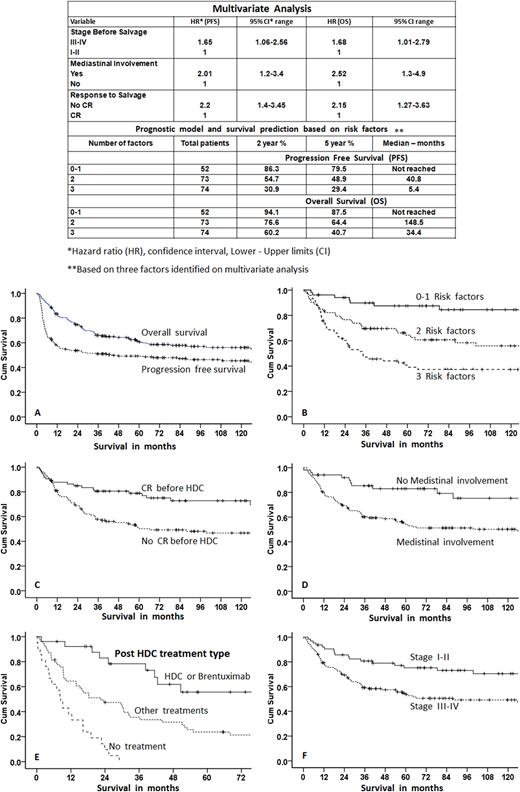Abstract
Background: High dose chemotherapy (HDC) and autologous stem cell transplantation (auto-SCT) can still salvage many patients with refractory Hodgkin lymphoma (HL). We are reporting patient's presentation, management and outcome of patients who underwent HDC auto-SCT at our institution and also analyzed the impact of various prognostic factors in these patients. We are reporting one of the largest single institution data and first report from the Middle Eastern countries analyzed to date.
Design: From 1996-2019, 200 consecutive patients with refractory HL underwent HDC auto-SCT in Adult Medical Oncology are included using retrospective/prospective transplant data base. Fine and Gray competing risk analysis method and regression model for outcome analysis was used. Kaplan-Meir (KM) method was used to estimate 5-year progression free survival (PFS), defined as the time from diagnosis to disease relapse or progression or start of salvage due to primary treatment failure or death from any cause, whichever came first. Overall survival (OS) was defined as the time from diagnosis to death from any cause.
Results: Male/female is 54.5%/45.5%, median age at auto-SCT is 22.75 years. Median follow-up is 106 months (12.5 - 271 months). Post HDC auto-SCT, disease status was complete remission (CR) 122 (61%), partial remission 22 (11%), no response 1 and progressive disease in 47 (23.5%) patients. Kaplan-Meir (KM) estimated median progression free survival (PFS) from HDC auto-SCT was 43.9 months (49.3% at 5 years, 45.5% at 10 years). Median overall survival (OS) was 168.6 months (61.2% at 5 years, 56.2% at 10 years). 115 (57.5%) patients are alive, 85 (44.5%) had died; 69 (34.5%) due to disease. Multivariate analysis identified three adverse risk-factors, similar for both PFS and OS. For PFS, stage III-IV at relapse (HR=1.65, P=0.045), mediastinal involvement (HR=2.01, , P=0.009) and no CR after salvage chemotherapy (HR=2.2, P=0.001) were significant. PFS for patients with 0-1 (not reached), vs 2 (40.8 months) vs 3 (5.4 months) risk-factors were significant (P=<0.000). For OS, stage III-IV at relapse (HR=1.68, P=0.045), mediastinal involvement (HR=2.52, P=0.007) and no CR after salvage chemotherapy (HR=2.15, P=0.004) were significant. OS with 0-1 (not reached), vs 2 (148.5 months) vs 3 (34.4 months) risk factors were highly significant (P=<0.000). Median OS after HDC auto-SCT failure was 23.6 months; for patients who received brentuximab or 2nd SCT (not reached): other treatment (22.5 months): supportive care only (8.4 months) was significant difference (P=<0.000). Using five-point risk factors based model (Figure E) for "post HDC auto-SCT failure outcome", (presence of stage III-IV, failure <12 months, tumor size >5 cm, B symptoms and low albumin) KM-OS in patients with 0-1 risk factor (152 months): 2 risk factors (30.9 months): 3-5 risk factors (9.45 months) was highly significant (P=<0.000).
Conclusion: Refractory HL patients have encouraging survival after HDC auto-SCT and can even be salvaged after auto-SCT failure. Various prognostic factors at various time frames can predict outcome and may help in selecting patients for various emerging therapies.
Disclosures
No relevant conflicts of interest to declare.
Author notes
Asterisk with author names denotes non-ASH members.


This feature is available to Subscribers Only
Sign In or Create an Account Close Modal